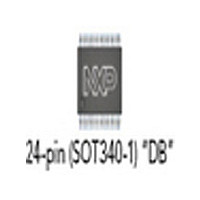TEA1095TS NXP Semiconductors, TEA1095TS Datasheet - Page 8

TEA1095TS
Manufacturer Part Number
TEA1095TS
Description
Manufacturer
NXP Semiconductors
Datasheet
1.TEA1095TS.pdf
(28 pages)
Specifications of TEA1095TS
Operating Temp Range
-25C to 75C
Package Type
SSOP
Pin Count
24
Operating Temperature Classification
Commercial
Mounting
Surface Mount
Lead Free Status / Rohs Status
Compliant
Available stocks
Company
Part Number
Manufacturer
Quantity
Price
Part Number:
TEA1095TS
Manufacturer:
PHILIPS/飞利浦
Quantity:
20 000
Philips Semiconductors
Receive channel
R
MUTERX
The TEA1095 has an asymmetrical input (RXIN) for the
receiver amplifier with an input resistance of 20 k . The
gain of the input stage varies according to the mode of the
TEA1095. In the receive mode, the gain is at its maximum;
in the transmit mode, it is at its minimum and in the idle
mode, it is halfway between maximum and minimum.
Switch-over from one mode to the other is smooth and
click-free.
In the receive mode, the overall gain of the receive
amplifier can be adjusted from 14 dB to +26 dB to suit
application specific requirements. The gain from RXIN to
RXOUT is proportional to the value of R
6.5 dB with R
parallel with R
low-pass filter.
By applying a HIGH level on pin MUTERX, the receiver
amplifier is muted and the TEA1095 is automatically
forced into the transmit mode.
1997 Nov 25
handbook, full pagewidth
ECEIVER AMPLIFIER
Voice switched speakerphone IC
to loudspeaker
amplifier
GARX
GARX
= 16.5 k . A capacitor connected in
can be used to provide a first-order
:
PINS
RXIN, GARX, RXOUT
R GARX
C GARX
GARX
RXOUT
MUTERX
GARX
and equals
V
Fig.5 Receive channel.
AND
I
8
V
The receiver amplifier gain can be adjusted with the
potentiometer R
obtain logarithmic control of the gain of the receiver
amplifier. Each 950
loss of 3 dB. The maximum gain reduction with the volume
control is internally limited to the switching range.
Duplex controller
S
TENV, TNOI, RSEN, RENV
The signal envelopes are used to monitor the signal level
strength in both channels. The noise envelopes are used
to monitor background noise in both channels. The signal
and noise envelopes provide inputs for the decision logic.
The signal and noise envelopes detectors are shown in
Fig.6.
For the transmit channel, the input signal at TXIN is 40 dB
amplified to TSEN. For the receive channel, the input
signal at RXIN is 0 dB amplified to RSEN. The signals from
TSEN and RSEN are logarithmically compressed and
buffered to TENV and RENV respectively. The sensitivity
of the envelope detectors is set with R
OLUME CONTROL
IGNAL AND NOISE ENVELOPE DETECTORS
voice switch
to/from
CONTROL
VOLUME
I
V
envelope
detector
to
VOL
:
RXIN
VOL
PIN
. A linear potentiometer can be used to
VOL
increase of R
R VOL
AND
from transmission
circuit
RNOI
VOL
Product specification
TSEN
MBG356
results in a gain
:
TEA1095
PINS
and R
TSEN,
RSEN
.
















